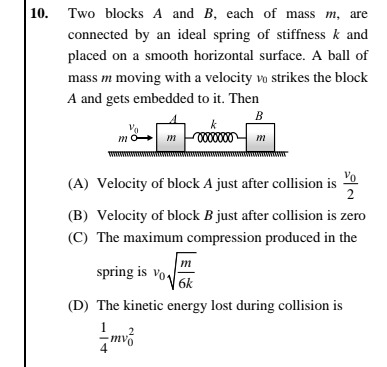Question
Question: Two blocks $A$ and $B$, each of mass $m$, are connected by an ideal spring of stiffness $k$ and plac...
Two blocks A and B, each of mass m, are connected by an ideal spring of stiffness k and placed on a smooth horizontal surface. A ball of mass m moving with a velocity v0 strikes the block A and gets embedded to it. Then

Velocity of block A just after collision is 2v0
Velocity of block B just after collision is zero
The maximum compression produced in the spring is v06km
The kinetic energy lost during collision is 41mv02
A, B, C, D
Solution
The problem involves two stages: an inelastic collision followed by the oscillatory motion of a spring-mass system.
Stage 1: Collision between the ball and block A
A ball of mass m moving with velocity v0 strikes block A (mass m) and gets embedded in it. This is a perfectly inelastic collision.
Let vA′ be the velocity of the combined mass (ball + block A) just after the collision.
Applying the principle of conservation of linear momentum:
Initial momentum = Final momentum
mv0+m(0)=(m+m)vA′
mv0=2mvA′
vA′=2v0
-
Option (A) Velocity of block A just after collision is 2v0
This is correct, as calculated above. -
Option (B) Velocity of block B just after collision is zero
Block B is not directly involved in the collision and is connected by a spring. The spring takes time to compress or expand and transmit force. Therefore, instantaneously, just after the collision, block B's velocity remains unchanged.
This is correct.
Stage 2: Motion of the combined system (ball+A) and block B
After the collision, the combined mass (ball + block A), let's call it M1=2m, moves with velocity vA′=2v0. Block B, let's call it M2=m, is at rest (vB=0). The spring is initially at its natural length.
The maximum compression in the spring occurs when both masses move with a common velocity, say vf. At this point, the relative velocity between M1 and M2 is zero.
Applying the principle of conservation of linear momentum for the system (M1+M2):
Initial momentum (just after collision) = Final momentum (at maximum compression)
M1vA′+M2vB=(M1+M2)vf
(2m)(2v0)+m(0)=(2m+m)vf
mv0=3mvf
vf=3v0
Now, apply the principle of conservation of mechanical energy from just after the collision to the point of maximum compression.
Initial mechanical energy (just after collision):
KEinitial=21M1(vA′)2+21M2(vB)2=21(2m)(2v0)2+21m(0)2=21(2m)4v02=4mv02
PEinitial=0 (spring is at natural length)
Final mechanical energy (at maximum compression xmax):
KEfinal=21(M1+M2)vf2=21(2m+m)(3v0)2=21(3m)9v02=6mv02
PEfinal=21kxmax2
By conservation of mechanical energy: KEinitial+PEinitial=KEfinal+PEfinal
4mv02+0=6mv02+21kxmax2
21kxmax2=4mv02−6mv02
21kxmax2=mv02(123−2)
21kxmax2=12mv02
kxmax2=6mv02
xmax2=6kmv02
xmax=v06km
- Option (C) The maximum compression produced in the spring is v06km
This is correct, as calculated above.
Stage 3: Kinetic energy lost during collision
The kinetic energy lost occurs only during the inelastic collision between the ball and block A.
Initial kinetic energy (before collision):
KEbefore=21mv02+21m(0)2=21mv02
Final kinetic energy (just after collision):
KEafter=21(2m)(vA′)2=21(2m)(2v0)2=21(2m)4v02=4mv02
Kinetic energy lost = KEbefore−KEafter
KElost=21mv02−4mv02=(21−41)mv02=41mv02
- Option (D) The kinetic energy lost during collision is 41mv02
This is correct, as calculated above.
All four options are correct.
